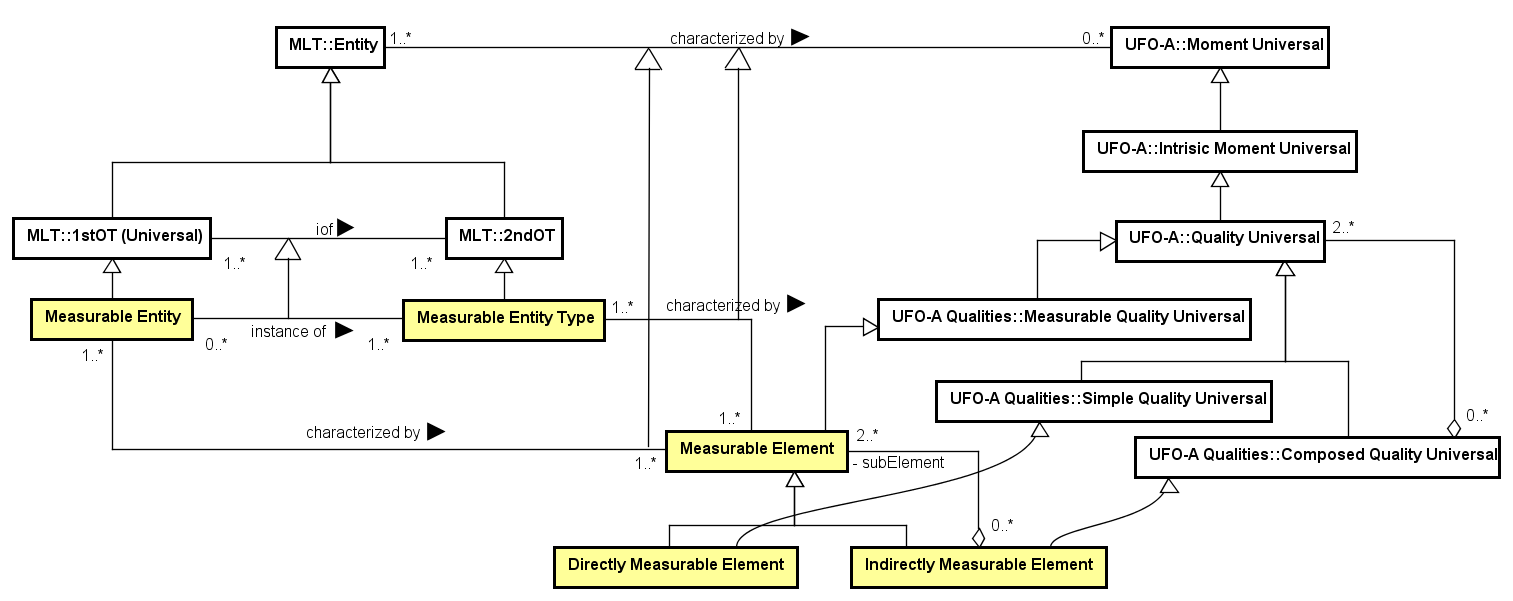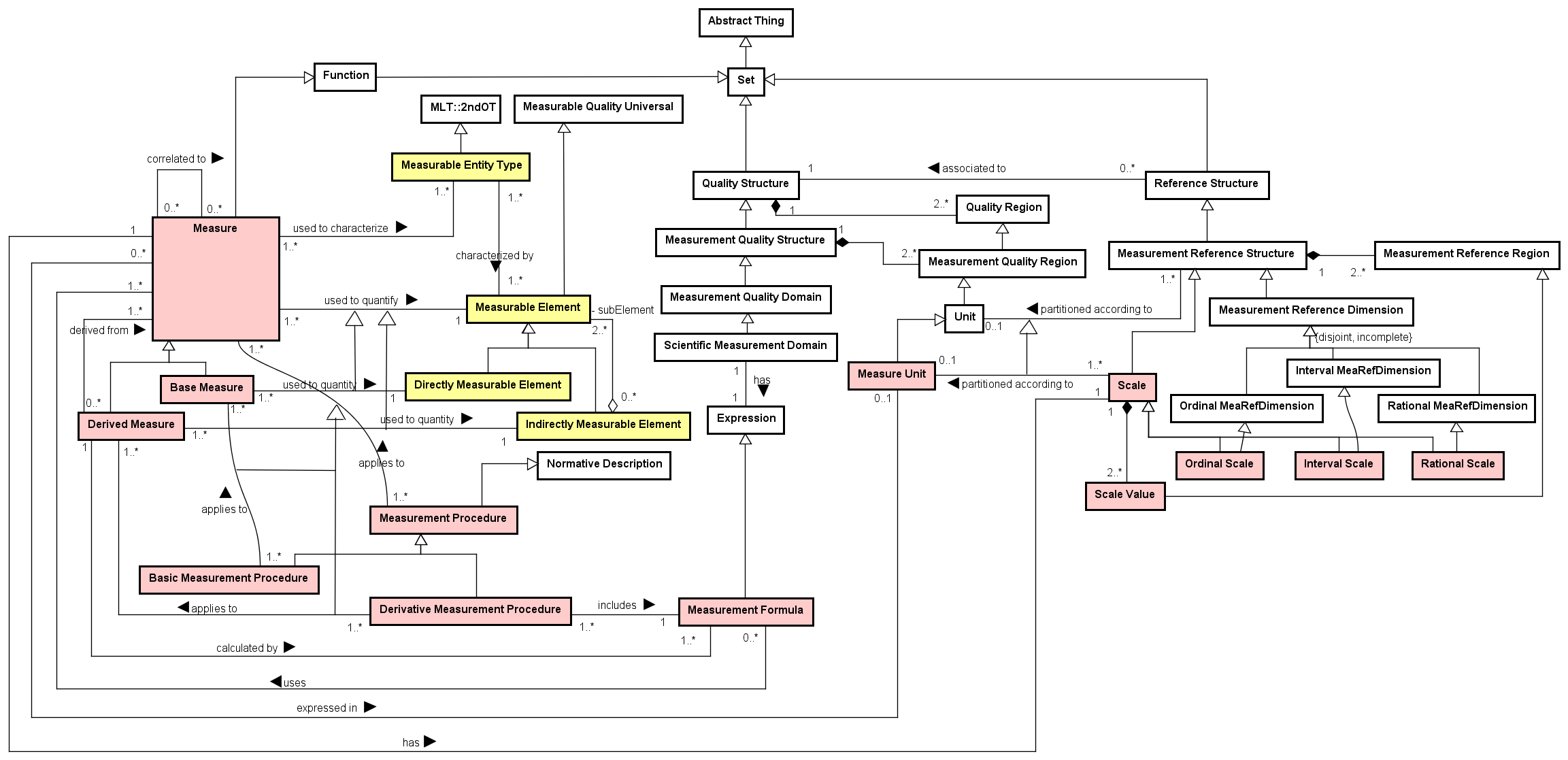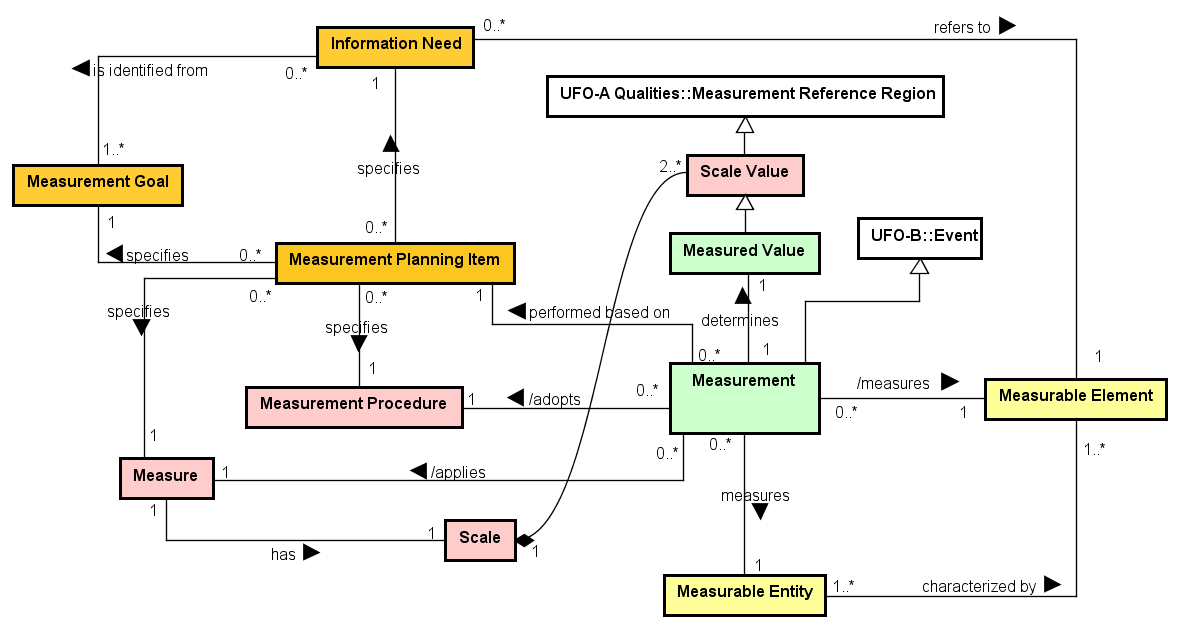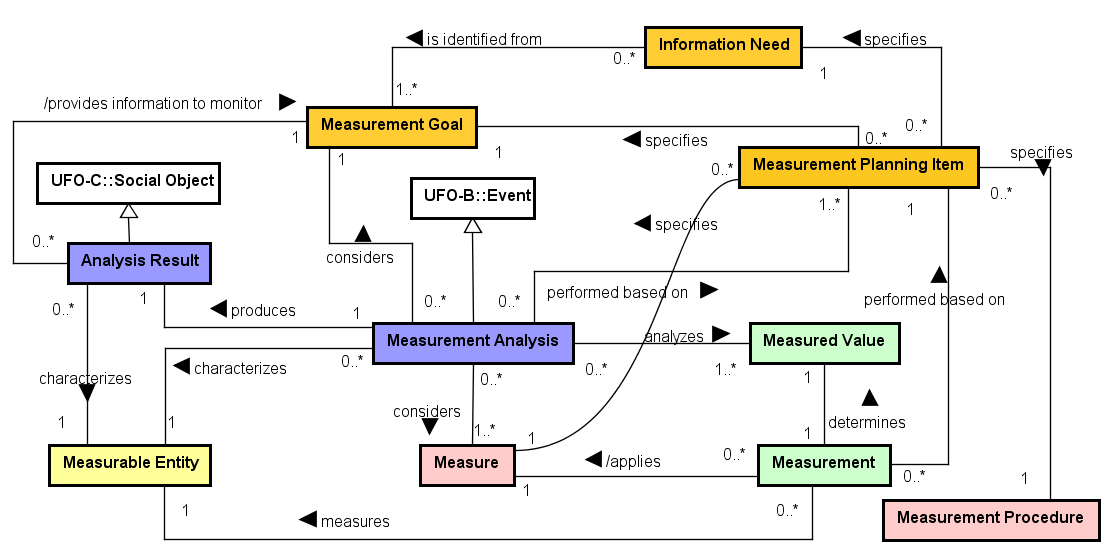
Networked ontologies used by COM:
| Ontology | Relation | Integration Level |
| UFO - Unified Foundational Ontology | The COM concepts are derived from UFO. | High |
Figure 1 presents the conceptual model of the 1 - Measurable Entities subontology.

Figure 1. 1 - Measurable Entities conceptual model.
Figure 2 presents the conceptual model of the 2 - Measure subontology.

Figure 2. 2 - Measure conceptual model.
Figure 3 presents the conceptual model of the 3-Measurement Planning subontology.

Figure 3. 3-Measurement Planning conceptual model.
Figure 4 presents the conceptual model of the 4 - Measurement subontology.

Figure 4. 4 - Measurement conceptual model.
Figure 5 presents the conceptual model of the 5 - Measurement Analysis subontology.

Figure 5. 5 - Measurement Analysis conceptual model.
The following table shows the definitions for COM concepts.
| Concept | Definition |
| Analysis Result
|
Result produced by a Measurement Analysis. An Analysis Result characterizes a Measurable Entity and provides information related to a Measurement Goal.
Ex.: the analysis of the measured values 26, 25.5 e 24, collected for the measure body mass index in kilos and meters to the measurable entity John could produce the analysis result: The patient’s body mass index decreased from an overweight to a normal weight value and the patient has now a good body mass index. This analysis result characterizes the measurable entity John and provides information to the measurement goal Check if the patient has a good body mass index. |
| Base Measure
|
Measure used to quantify a Directly Measurable Element.
Ex.: the base measure height in meters can be used to quantify the directly measurable element height. |
| Basic Measurement Procedure
|
Measurement Procedure applicable to a Base Measure.
Ex.: Measurement procedure to collect data for the measure weight in kilos: Use a weighting digital instrument to measure the person weight in kilos. Record the measured value and the measurement date. |
| Complex Goal
|
Goal that is composed by others.
Ex.: the complex goal Monitor the patient health could be decomposed in Check if the patient has a good body mass index and Check if the patient has a good blood pressure. |
| Derivative Measurement Procedure
|
Measurement Procedure applicable to a Derived Measure.
Ex.: Measurement procedure to collect data for the measure body mass index in kilos and meters: Obtain the values measured to the measures weight in kilos and and height in meters considering a same measurement date. Apply the measurement formula to calculate the body mass index in kilos and meters. Record the measured value and the measurement date. |
| Derived Measure
|
Measure used to quantify an Indirectly Measurable Element.
Ex.: the measure body mass index in kilos and meters can be used to quantify the indirectly measurable element body mass index. |
| Directly Measurable Element
|
Measurable Element that does not depend on others to be measured.
Ex.: weight and height. |
| Indicator
|
Measure directly used to indicate the achievement of Measurement Goals.
Ex.: the measure body mass index in kilos and meters could play the role of indicator when indicating the achievement of the measurement goal Check if the patient has a good body mass index. |
| Indirectly Measurable Element
|
Measurable Element that depends on others (its sub-elements) to be measured.
Ex.: body mass index is an indirectly measurable element measured from weight and height. |
| Information Need
|
Information Needs are identified from Measurement Goals and determine which information have to be met by Measures in order to monitor the achievement of the related Measurement Goal.
Ex.: the information need What is the patient body mass index? could be identified from the measurement goal Check if the patient has a good body mass index. |
| Interval Scale
|
Scale in which it is possible to quantify the distance between its Scale Values and there is not a value to represent nonentity (absolute zero). In an Interval Scale, although it is possible to quantify the distance between Scale Values, it is not possible to establish other relations between them.
Ex.: the measure temperature in Celsius degree has an interval scale, since it is possible to quantify the distance between its scale values (e.g., there are 10o between the temperatures 20oC and 30oC), 0oC does not mean the absence of temperature and it is not possible to establish relations between scale values (e.g., we cannot say that 50oC is twice hotter than 25oC). |
| Measurable Element
|
Measurable property that characterizes a Measurable Entity Type.
Ex.: height is a measurable element that characterizes measurable entities of the Person type. |
| Measurable Entity
|
Anything that can be measured.
Ex.: a person, a project, an organization. |
| Measurable Entity Type
|
Type of entities that can be measured.
Ex.: John is a measurable entity of the type Person. |
| Measure
|
Function used to associate a value (Measured Value) to a Measurable Element of a Measurable Entity. Measures quantify Measurable Elements and characterize Measurable Entity Types.
Ex.: the measure height in meters can be used to quantify the measurable element height of measurable entities of the type Person. |
| Measure Unit
|
Unit in which measures can be expressed.
Ex.: meter, kilo, hour. |
| Measured Value
|
Value obtained in a Measurement.
Ex.: the measured value 75 obtained in the measurement of the measurable element weight of the measurable entity John by applying the measure weight in kilos. |
| Measurement
|
Action that measures a Measurable Element of a Measurable Entity by applying a Measure and adopting a Measurement Procedure to obtain a Measured Value. A Measurement is performed based on a Measurement Planning Item.
Ex.: the measurement of the measurable element weight of the measurable entity John by applying the measure weight in kilos, adopting a certain measurement procedure and resulting in the measured value 75. |
| Measurement Analysis
|
Action that analyzes Measure Values collected for Measures aiming to characterize a Measurable Entity and provide information related to a Measurement Goal.
Ex.: a measurement analysis could analyze the measured values 26, 25.5 e 24, collected for the measure body mass index in kilos and meters to characterize the measurable entity John. |
| Measurement Formula
|
Formula that quantifies relations between Measures from which a Derived Measure is obtained.
Ex.: the measure body mass index in kilos and meters (BMI) can be calculated from the measures weight in kilos (w) and height in meters (h) by applying the measurement formula BMI = w/(h*h). |
| Measurement Goal
|
Goal that can be used to drive the identification of the Measures needed to provide information in a certain context. Measurement Goals are established based on more general Goals.
Ex.: in the context of a doctor’s office, a doctor could be the general goal of Taking a good care of the patients. From this general goal, could be established the measurement goal Monitor the patient health, which could be decomposed in others, such as Check if the patient has a good body mass index and Check if the patient has a good blood pressure. |
| Measurement Planning
|
Action that plans the measurement, i.e., determines the Measurement Goals to be monitored, the Information Needs to be considered, the Measures to be collected to meet the Information Needs and the Measurement Procedures to be applied.
|
| Measurement Planning Item
|
Social Object produced during Measurement Planning. A Measurement Planning Item specifies a Measurement Goal to be monitored, an Information Need to be considered, a Measure to be used to meet the Information Need and a Measurement Procedure to be applied to collect data for the Measure. Several Measurement Planning Items can be produced during Measurement Planning.
Ex.: the measurement planning item specifying the measurement goal Check if the patient has a good body mass index, the information need What is the patient body mass index?, the measure body mass index in kilos and meters to be collected by using the measurement procedure Obtain the values measured to the measures weight in grams and and height in centimeters considering a same measurement date; apply the measurement formula to calculate the body mass index in kilos and meters; record the measured value and the measurement date. |
| Measurement Procedure
|
Procedure applicable to a Measure and that describe the steps to be carried out to collect data for it.
Ex.: Measurement procedure to collect data for the measure weight in kilos: Use a weighting digital instrument to measure the person weight in kilos. Record the measured value and the measurement date. |
| Ordinal Scale
|
Scale whose Scale Values can be mapped to a certain order or ranking.
Ex.: the measure client satisfaction degree, which can be mapped to the values “high”, “medium” or “low”, has an Ordinal Scale. |
| Rational Scale
|
Scale in which it is possible to quantify the distance between its Scale Values, there is a value to represent nonentity (absolute zero) and it is possible to establish relations between Scale Values.
Ex.: the measure distance in kilometers has a rational scale, since 0km means the absence of distance, it is possible to quantify the distance between scale values (e.g., there are 10km between the distances 20km and 30km) as well as establish other relations between them (e.g., we can say that 100km is twice longer than 50km). |
| Scale
|
Delimitates the space of values possible to be associated by a Measure to a Measurable Element.
Ex.: the scale of the measure height in meters is a liner structure isomorphic to the positive half-line of the real numbers. |
| Scale Value
|
Value that compose a Scale.
Ex.: 0.5, 1, 1.8 are examples of values that compose the scale of the measure height in meters. |
| Simple Goal
|
Goal that is not composed by others.
Ex.: Monitor the patient’s blood pressure. |
| Analysis Result |
Analysis Result (1..1) produces (1..1) Measurement Analysis
Analysis Result (0..*) characterizes (1..1) Measurable Entity
Analysis Result (0..*) /provides information to monitor (1..1) Measurement Goal
Analysis Result Description (0..1) describes (1..1) Analysis Result
| Base Measure |
Base Measure (1..*) used to quantity (1..1) Directly Measurable Element
Basic Measurement Procedure (1..*) applies to (1..*) Base Measure
| Basic Measurement Procedure |
Basic Measurement Procedure (1..*) applies to (1..*) Base Measure
| Complex Goal |
Complex Goal (0..*) <>-- (1..*) Goal
| Derivative Measurement Procedure |
Derivative Measurement Procedure (1..*) applies to (1..*) Derived Measure
Derivative Measurement Procedure (1..*) includes (1..1) Measurement Formula
| Derived Measure |
Derived Measure (0..*) derived from (1..*) Measure
Derived Measure (1..1) calculated by (1..*) Measurement Formula
Derived Measure (1..*) used to quantity (1..1) Indirectly Measurable Element
Derivative Measurement Procedure (1..*) applies to (1..*) Derived Measure
| Directly Measurable Element |
Base Measure (1..*) used to quantity (1..1) Directly Measurable Element
| Indicator |
Indicator (1..*) indicates achievement of (1..*) Measurement Goal
| Indirectly Measurable Element |
Indirectly Measurable Element (0..*) <>-- (2..*) Measurable Element
Derived Measure (1..*) used to quantity (1..1) Indirectly Measurable Element
| Information Need |
Information Need (1..1) specifies (0..*) Measurement Planning Item
Measurable Element (1..1) refers to (0..*) Information Need
Measurement Goal (1..*) is identified from (0..*) Information Need
Measurable Entity Type (1..1) refers to (0..*) Information Need
Measure (0..*) meets (0..*) Information Need
Information Need Description (0..1) describes (1..1) Information Need
| Interval Scale |
| Measurable Element |
Measurable Element (1..*) characterized by (1..*) Measurable Entity Type
Measurable Element (1..1) refers to (0..*) Information Need
Measurable Entity (1..*) characterized by (1..*) Measurable Element
Measurement (0..*) /measures (1..1) Measurable Element
Measure (1..*) used to quantify (1..1) Measurable Element
Operational Definition of Measure (0..*) indicates (1..1) Measurable Element
Indirectly Measurable Element (0..*) <>-- (2..*) Measurable Element
| Measurable Entity |
Measurable Entity (1..*) characterized by (1..*) Measurable Element
Measurable Entity (0..*) instance of (1..*) Measurable Entity Type
Analysis Result (0..*) characterizes (1..1) Measurable Entity
Measurement Analysis (0..*) characterizes (1..1) Measurable Entity
Measurement (0..*) measures (1..1) Measurable Entity
| Measurable Entity Type |
Measurable Entity Type (1..1) refers to (0..*) Information Need
Measurable Element (1..*) characterized by (1..*) Measurable Entity Type
Measurable Entity (0..*) instance of (1..*) Measurable Entity Type
Measure (1..*) used to characterize (1..*) Measurable Entity Type
| Measure |
Measure (1..*) used to quantify (1..1) Measurable Element
Measure (0..*) expressed in (0..1) Measure Unit
Measure (1..1) has (1..1) Scale
Measure (1..*) used to characterize (1..*) Measurable Entity Type
Measure (0..*) correlated to (0..*) Measure
Measure (0..*) meets (0..*) Information Need
Measure (1..1) specifies (0..*) Measurement Planning Item
Measurement Procedure (1..*) applies to (1..*) Measure
Measurement Analysis (0..*) considers (1..*) Measure
Measurement Formula (0..*) uses (1..*) Measure
Measurement Analysis Procedure (0..*) applies to (1..*) Measure
Measurement (0..*) /applies (1..1) Measure
Derived Measure (0..*) derived from (1..*) Measure
| Measure Unit |
Measure (0..*) expressed in (0..1) Measure Unit
Scale (1..*) partitioned according to (0..1) Measure Unit
| Measured Value |
Measurement Analysis (0..*) analyzes (1..*) Measured Value
Measured Value Description (0..1) describes (1..1) Measured Value
Measurement (1..1) determines (1..1) Measured Value
| Measurement |
Measurement (0..*) /adopts (1..1) Measurement Procedure
Measurement (0..*) measures (1..1) Measurable Entity
Measurement (0..*) /measures (1..1) Measurable Element
Measurement (0..*) /applies (1..1) Measure
Measurement (1..1) determines (1..1) Measured Value
Measurement Planning Item (1..1) performed based on (0..*) Measurement
| Measurement Analysis |
Measurement Analysis (0..*) considers (1..*) Measure
Measurement Analysis (0..*) analyzes (1..*) Measured Value
Measurement Analysis (0..*) characterizes (1..1) Measurable Entity
Measurement Analysis (0..*) considers (1..1) Measurement Goal
Analysis Result (1..1) produces (1..1) Measurement Analysis
Measurement Planning Item (1..*) performed based on (0..*) Measurement Analysis
| Measurement Formula |
Measurement Formula (0..*) uses (1..*) Measure
Derived Measure (1..1) calculated by (1..*) Measurement Formula
Derivative Measurement Procedure (1..*) includes (1..1) Measurement Formula
| Measurement Goal |
Measurement Goal (1..*) is identified from (0..*) Information Need
Measurement Goal (1..1) specifies (0..*) Measurement Planning Item
Measurement Goal (0..*) based on (1..*) Goal
Analysis Result (0..*) /provides information to monitor (1..1) Measurement Goal
Measurement Analysis (0..*) considers (1..1) Measurement Goal
Indicator (1..*) indicates achievement of (1..*) Measurement Goal
| Measurement Planning |
Measurement Planning (1..1) produces (1..*) Measurement Planning Item
| Measurement Planning Item |
Measurement Planning Item (0..*) specifies (1..1) Measurement Procedure
Measurement Planning Item (1..1) performed based on (0..*) Measurement
Measurement Planning Item (1..*) performed based on (0..*) Measurement Analysis
Measurement Goal (1..1) specifies (0..*) Measurement Planning Item
Measurement Planning (1..1) produces (1..*) Measurement Planning Item
Measure (1..1) specifies (0..*) Measurement Planning Item
Information Need (1..1) specifies (0..*) Measurement Planning Item
| Measurement Procedure |
Measurement Procedure (1..*) applies to (1..*) Measure
Measurement Planning Item (0..*) specifies (1..1) Measurement Procedure
Measurement (0..*) /adopts (1..1) Measurement Procedure
Operational Definition of Measure (0..*) indicates (1..1) Measurement Procedure
| Ordinal Scale |
| Rational Scale |
| Scale |
Scale (1..1) <>-- (2..*) Scale Value
Scale (1..*) partitioned according to (0..1) Measure Unit
Measure (1..1) has (1..1) Scale
| Scale Value |
Scale (1..1) <>-- (2..*) Scale Value
| Simple Goal |